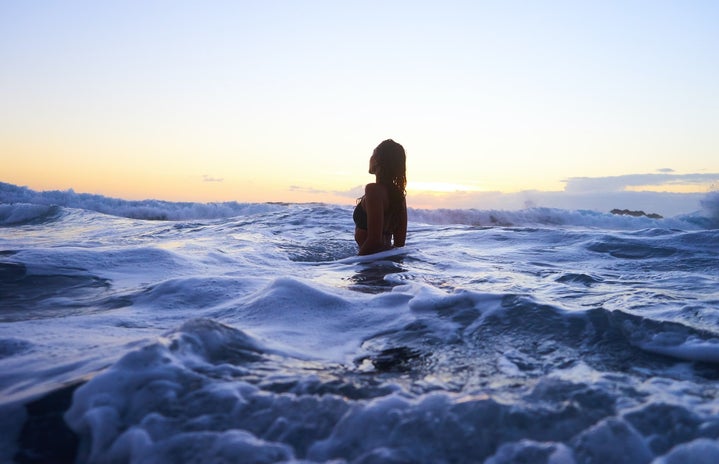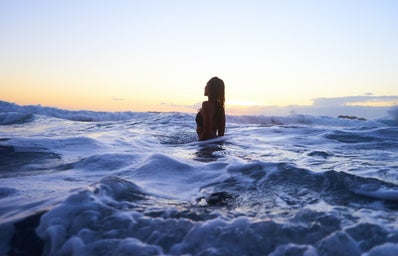As the summer season nears and most of the country (especially the University of Connecticut) recently received a sneak peek of the scorching hot weather to come, it’s once again time to shed long sleeves and winter boots in exchange for swimsuits and tank tops. Ever since COVID-19 kept activities to a limit, a new summer hobby of mine became lounging in my backyard in the hot summer sun either reading, listening to a podcast, watching TV, or playing music pretending I’m at the beach (since I’m too lazy to drive there)! However, the pandemic started over three years ago, and as we age, so does our skin.
Like most children, I was more annoyed than excited about taking care of my skin before spending long days in the sun. Reapplying sunscreen every hour on the beach was tedious, and I always hated the shiny, oily feeling. I paid even less attention to my face, as my naturally tan skin was already less prone to burning. When I finally started wearing makeup, using moisturizer before foundation was never a part of my routine. UV rays, however, are a threat regardless of skin type and skin tone. Not only can they lead to the more obvious aftereffects, such as burning and skin cancer, but UV rays can damage skin cells over the years, resulting in loss of elasticity and firmness in the face, as well as early wrinkling and spots all over the body.
Skincare and body care have been getting their well-deserved hype over the past few years, but it’s hard to keep up a proper routine when these techniques can deter tanning and achieving that warmer, summery glow. However, taking care of your skin and actively working to prevent the negative effects of UV rays does not equate to no tan. In my experience, taking care of my skin before tanning actually resulted in softer skin accompanied by a perfectly colored, healthier-looking tan. Here are some of the tips to consider over the summer to protect yourself while still enjoying the heat and getting a gorgeous tan in no time.
- Sunscreen & the ocean
-
If you live in an area that experiences snowstorms at least once a year, you know that the morning after a snowstorm is even brighter than the sunniest day of summer. Using that same logic, tanning is actually easier at a beach than your backyard because of the sand. The light colors of the sand are much better at naturally reflecting light compared to the grass or a lounge chair, so you are automatically exposed to more UV rays when laying at the beach. Evidently, this calls for sunscreen, with application every two hours. Some daily moisturizers include SPF 15-30, but they are only 93 and 97% protective, allowing 3-7 photons to enter the skin per 100 photons. That doesn’t sound so bad at first, until learning that the sun emits thousands to millions of photons per second. On a beach trip, I’ll typically use a sunscreen with SPF 50 (98%) on the first day to get the best effects of tanning, then either use SPF 70 or spend time under my umbrella toward the end. Even with SPF 50, you can still get an extreme tan, especially if the UV is high! Many brands have been coming out with sunscreens for all skin types, including non-greasy sunscreen for people like me, who absolutely hate the feeling of it.
For my pool and ocean lovers, you’re in luck! Water is even more reflective than sand, and taking a dip not only means a refreshing cool-off from hot weather, but also that UV rays are hitting your entire body from all angles at all times. I’ve quickly learned that tanning for an hour in the ocean gets me the same amount of color as relaxing on the sand for 2-3 hours. So if you’re short on time, or simply want to tan a lot faster, going for a swim is seriously effective! Just make sure to use sunscreen twice as often, as obviously, the water is going to wash it off a lot quicker.
Anna Schultz / Her Campus - uV 7-9
-
Considered by the World Health Organization (WHO) as “High” to “Very high” indices, UV 7-9, in my experience, has been the ideal UV for tanning without risking skin damage and heat exhaustion. Under these conditions, it takes about 25-30 minutes to burn without protection. In the peak of summer, these UVs occur before 12 in the afternoon, meaning temperatures (and the sun’s rays) are just right.
UV 11 is considered “Extreme” by the WHO, and 10 seems to be seriously cutting it close. Here, it takes 15 minutes or less to burn. Especially since UV 10-11 occur with perfectly sunny days and temperatures above 85, the conditions do not feel as ideal on the body as they look in the forecast. Tanning under lower UVs has always been much more enjoyable, as you won’t find yourself sweating too much, feeling dehydrated, or experiencing heat exhaustion.
- Moisturize. always.
-
Aside from protecting against UV rays, keeping your skin cool and hydrated is one of the most important factors of skin care. It may feel counterproductive to apply two separate things to your face, but moisturizing before applying sunscreen maintains the benefits of your usual routine with the added assistance of UV protection.
Don’t forget to read your labels! If you use mineral/physical sunscreen, you should apply moisturizer before sunscreen. Chemical sunscreen contains ingredients that need to be absorbed by the skin to take effect, so sunscreen should be applied before your layer of moisturizer.
After a long pool or beach day, it’s even more important to rehydrate your body and moisturize. Brands like Hawaiian Tropic, Sun Bum, and Burt’s Bees have moisturizers and lotions to apply to the body after a post-beach shower. These “after sun” lotions are accompanied with hydrating ingredients and a cooling effect, as well as summery smells like coconut, cocoa butter, and papaya.
- use that hat
-
Even with moisturizing, reapplying SPF 50 sunscreen, and a day that only has a max of UV 8, shade is still your best friend. Unlike the rest of our bodies, the skin on our faces is much thinner, meaning it’s automatically much more sensitive to the heat and UV. Especially when the weather is really warm, your face may feel like it’s overheating and burning, and suddenly the experience is much less relaxing. Your face also tans a lot more often over the summer than the rest of you, since it’s the only part of your body that’s almost always exposed.
Typically, I’ll either wear a baseball cap or hat while tanning and leave it over my face if I’m laying on my back. Taking extensive breaks while tanning doesn’t hurt either! Your body can easily tire out due to sweating from high temperatures and lack of hydration, so regrouping every once in a while to cool off and rehydrate helps more than hurts.
- acne treatment = serious sun sensitivity
-
Dermatologists and the products themselves already make this pretty clear, but if you use topical acne medicine, you are much more at risk of sun damage and its effects due to the ingredients in your medicine. Retinoids, benzoyl peroxide, and Alpha Hydroxy Acids, found in most acne treatments, increase photosensitivity, the skin’s sensitivity to UV rays. Since I already mentioned how thin the layers of skin are on the face, you should either briefly pause your usual routine (if possible) for a day or two to let your skin rest or take extra precautions (SPF 70-100) while laying out in the sun.



